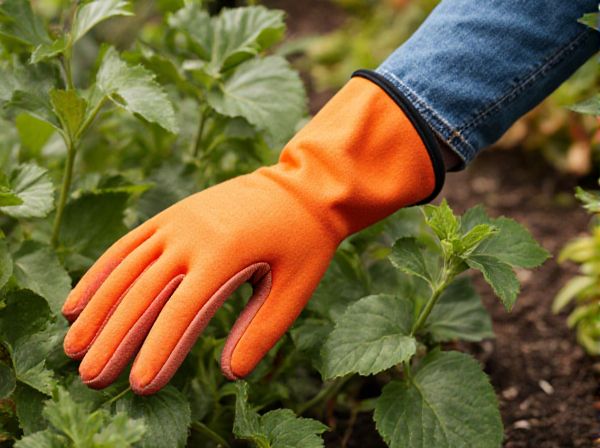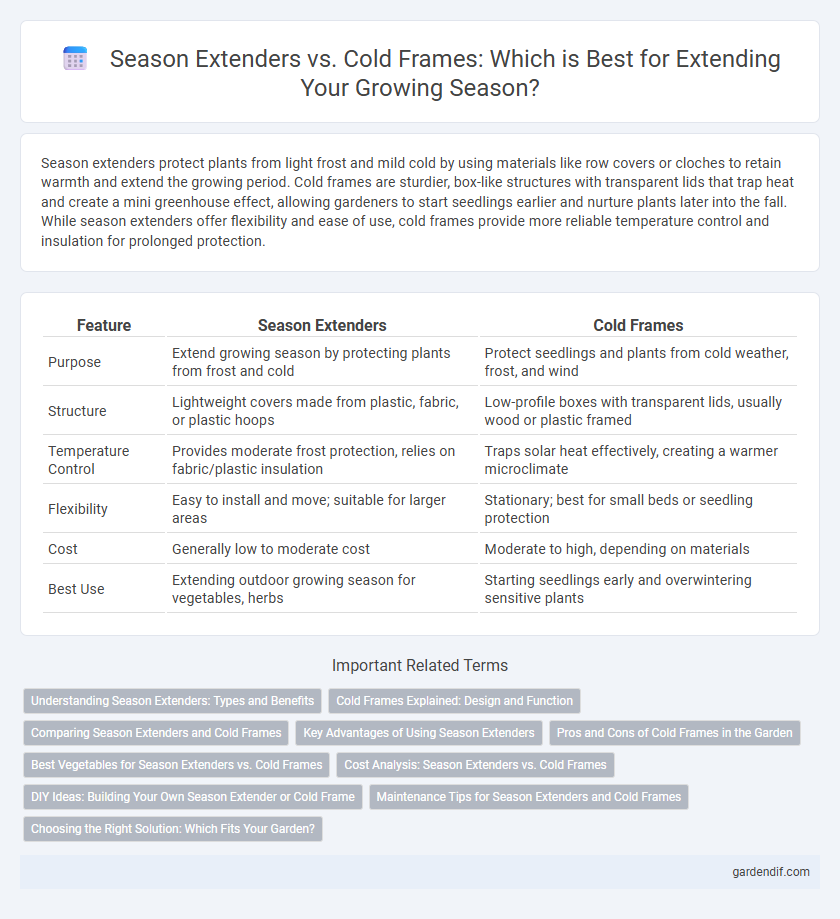
Season extenders vs Cold frames Illustration
Season extenders protect plants from light frost and mild cold by using materials like row covers or cloches to retain warmth and extend the growing period. Cold frames are sturdier, box-like structures with transparent lids that trap heat and create a mini greenhouse effect, allowing gardeners to start seedlings earlier and nurture plants later into the fall. While season extenders offer flexibility and ease of use, cold frames provide more reliable temperature control and insulation for prolonged protection.
Table of Comparison
| Feature | Season Extenders | Cold Frames |
|---|---|---|
| Purpose | Extend growing season by protecting plants from frost and cold | Protect seedlings and plants from cold weather, frost, and wind |
| Structure | Lightweight covers made from plastic, fabric, or plastic hoops | Low-profile boxes with transparent lids, usually wood or plastic framed |
| Temperature Control | Provides moderate frost protection, relies on fabric/plastic insulation | Traps solar heat effectively, creating a warmer microclimate |
| Flexibility | Easy to install and move; suitable for larger areas | Stationary; best for small beds or seedling protection |
| Cost | Generally low to moderate cost | Moderate to high, depending on materials |
| Best Use | Extending outdoor growing season for vegetables, herbs | Starting seedlings early and overwintering sensitive plants |
Understanding Season Extenders: Types and Benefits
Season extenders such as row covers, hoop houses, and plastic tunnels provide flexible protection to crops by insulating against temperature fluctuations and extending growing periods beyond typical frost dates. Unlike cold frames, which are rigid structures primarily designed to trap solar heat and shield plants from harsh weather, season extenders offer more versatility and can be adapted to various garden sizes and needs. Their benefits include increased crop yields, earlier planting, and reduced risk of frost damage, making them essential tools for optimizing growing seasons in diverse climates.
Cold Frames Explained: Design and Function
Cold frames are simple, low-profile structures made of a wooden or metal frame with a transparent top, typically glass or plastic, designed to protect plants from cold weather by trapping solar heat. They function by creating a microclimate that extends the growing season by sheltering seedlings and tender plants from frost, wind, and chilling temperatures. Their design maximizes sunlight exposure while allowing ventilation to regulate temperature and humidity, making them an essential tool for gardeners seeking to start plants earlier or harvest crops later in the season.
Comparing Season Extenders and Cold Frames
Season extenders and cold frames both provide valuable protection for plants during colder months, but season extenders typically cover larger areas and use materials like plastic or fabric to retain heat. Cold frames are smaller, box-like structures with transparent tops that trap solar energy, ideal for hardening off seedlings and extending growing periods in limited spaces. Choosing between season extenders and cold frames depends on garden size, plant variety, and desired temperature control efficiency.
Key Advantages of Using Season Extenders
Season extenders provide key advantages by offering enhanced insulation and protection against frost, allowing gardeners to prolong the growing season beyond traditional limits. They facilitate earlier planting and later harvesting, reducing the risk of crop damage due to sudden temperature drops. Compared to cold frames, season extenders often feature more flexible designs and better temperature regulation, optimizing plant growth conditions.
Pros and Cons of Cold Frames in the Garden
Cold frames offer a simple, cost-effective method for extending the growing season by providing a controlled environment that protects plants from frost and wind. However, they can limit airflow and become overheated on sunny days, requiring regular monitoring and ventilation to prevent plant stress. Their compact size is ideal for small gardens but may not accommodate larger crops or extensive year-round use compared to more advanced season extenders.
Best Vegetables for Season Extenders vs. Cold Frames
Season extenders like hoop houses and row covers excel at growing leafy greens such as spinach, kale, and lettuce by providing extended warmth and protection from light frost. Cold frames are ideal for hardier vegetables including carrots, radishes, and broccoli, as they offer insulation while allowing gradual acclimation to outdoor conditions. Selecting the right container depends on the vegetable's cold tolerance and desired harvest time for optimized growth.
Cost Analysis: Season Extenders vs. Cold Frames
Season extenders typically offer a lower initial investment compared to cold frames, making them more accessible for casual gardeners. Cold frames require more durable materials such as wood or polycarbonate panels, increasing upfront costs but providing better insulation and longevity. Over time, season extenders may incur additional expenses through replacements and maintenance, while cold frames generally provide greater cost-efficiency through repeated use across multiple growing seasons.
DIY Ideas: Building Your Own Season Extender or Cold Frame
Building your own season extender or cold frame can significantly prolong your gardening season by protecting plants from frost and cold temperatures. DIY season extenders often involve using materials like PVC pipes, plastic sheeting, and wooden frames, while cold frames typically utilize a transparent lid made from glass or acrylic to trap heat and sunlight. Incorporating recycled materials and ensuring proper ventilation are key strategies to optimize plant growth and reduce costs in homemade cold frame or season extender projects.
Maintenance Tips for Season Extenders and Cold Frames
Season extenders require regular inspection of plastic covers for tears and prompt replacement to maintain insulation efficiency. Cold frames benefit from routine cleaning of glass panels and removal of debris to maximize sunlight penetration and prevent mold growth. Both structures should have hinges and ventilation mechanisms lubricated seasonally to ensure proper airflow and temperature control.
Choosing the Right Solution: Which Fits Your Garden?
Season extenders like row covers and hoop tunnels provide flexible protection against mild frosts, ideal for smaller plants or quick setups in gardens with limited space. Cold frames offer a sturdier, insulated environment suitable for starting seedlings earlier and extending harvests in colder climates, requiring more initial investment and space. Gardeners should assess their local weather patterns, plant types, and available garden area to choose the solution that balances cost, convenience, and effectiveness.
Season extenders vs Cold frames Infographic

 gardendif.com
gardendif.com